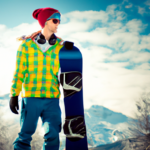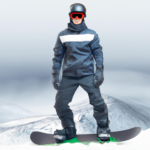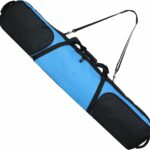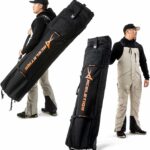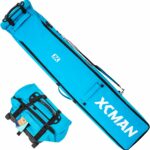Are you geared up for an exciting snowboarding trip? There’s a thrill that comes with gliding down snowy slopes, but the nip in the air can quickly freeze the fun if you’re not dressed properly. The importance of suitable attire while snowboarding simply cannot be understated. As you find yourself standing on top of that hill, ready to make a breathtaking run, you’ll want comfort, warmth, and of course, style on your side. This article, “What To Wear For Snowboarding?” is jam-packed with insightful tips on assembling the perfect snowboarding attire, addressing key elements like suitable fabrics, layering techniques, and essential accessories to ensure you have a frosty fun time without any discomfort.
Understanding the Basics of Dressing for Snowboarding
Snowboarding is a thrilling and captivating sport. However, to enjoy it to the fullest, you must know the ins and outs of proper dress code, because the cold mountain environment can be merciless if you’re not well-prepared.
Why dressing appropriately for snowboarding is important
Dressing appropriately for snowboarding is crucial for your safety, comfort, and performance. Being cold can not only spoil your fun but can also lead to serious health issues like hypothermia. When you dress correctly, you feel comfortable, you can move freely, and you stay protected against weather elements.
The concept of layering: Base, Mid, and Outer
When dressing for snowboarding, think in terms of three layers: the base layer, mid layer, and outer layer. The base layer wicks away moisture from your body to keep you dry. The mid layer is your insulation to keep you warm, and the outer layer serves as a protective shield against external weather elements.
Importance of moisture-wicking and insulating materials
Picking the right fabrics for your snowboarding outfit is vital. Opt for moisture-wicking and insulating materials. Moisture-wicking materials keep sweat off your skin, preventing dampness, while insulating materials help maintain your body heat, keeping you snug and warm.
Choosing Your Base Layer
Your base layer plays a crucial role in maintaining your body temperature while you enjoy snowboarding.
The role of the base layer in keeping you dry
The base layer keeps you dry by absorbing sweat and transferring it to the surface of the fabric from where it evaporates. Staying dry is key to preventing hypothermia while on the slopes.
Optimal materials for base layer
While choosing the material for your base layer, consider materials like synthetic polyester, merino wool, or silk which offer excellent moisture-wicking properties, and avoid cotton as it retains moisture.
Base layer options: long underwear, thermal tops, and more
Options for your base layer include long underwear, thermal tops, leggings, and more. Opt for a snug fit, but ensure it doesn’t restrict your movement.
Selecting Your Mid Layer
Your mid layer serves as your insulation and is critical for keeping you warm on the slopes.
Importance of insulation in the mid layer
The mid layer insulates by capturing warm air between the fabric layers. This trapped air minimizes heat loss and keeps you warm even in frosty conditions.
Materials worth considering for mid layer
Consider materials like fleece, down, and synthetic insulation for your mid layer. These materials offer impressive insulation and are lightweight.
Mid layer choices: Fleece jackets, down jackets, etc.
Options for the mid layer include fleece jackets, down jackets, and synthetic jackets. Your mid layer should offer comfort and freedom to move while maintaining your body warmth.
Opting for the Right Outer Layer
The outer layer is your primary defense against wind, snow, and rain while snowboarding.
The protection needed from an outer layer
Your outer layer should offer protection from wind, precipitation, and should be durable. It should also vent out sweat vapor so that your inner layers remain dry.
Evaluating weatherproof qualities: Waterproof, windproof, and breathability ratings
When choosing your outer layer, check for qualities like waterproof, windproof, and breathability ratings. These critical factors determine whether the outer layer can protect you from harsh weather conditions or not.
Best outer layer options: Snowboarding jackets and snow pants
The best options for an outer layer are snowboarding jackets and snow pants. These are specially designed to withstand harsh winter conditions while offering the necessary comfort and flexibility.
Picking Suitable Snowboarding Socks
Selecting the right snowboarding socks is more crucial than you may realize.
Why regular socks aren’t sufficient for snowboarding
Regular socks lack the necessary properties for snowboarding. They might not provide the warmth you need, might become wet and cold quickly, and can cause irritation leading to blisters.
Choosing materials for snowboarding socks
go for socks made from materials that offer excellent moisture-wicking and insulating properties. Merino wool or synthetics like polyester are great choices. The correct length and thickness for snowboarding socks
The ideal snowboarding socks must be of an adequate length to prevent snow from getting in, and thickness to offer warmth without hampering the fit of your snowboarding boots.
Wearing Proper Snowboarding Gloves or Mittens
Keeping your hands warm and dry is crucial for your comfort and ability to control your snowboard.
Mittens vs. Gloves: Which one to choose
While mittens tend to be warmer than gloves, gloves offer better dexterity. The choice between mittens and gloves depends on personal preference and weather conditions.
Must-have features in snowboarding gloves or mittens
Look for water-resistant, insulated, and breathable gloves or mittens. Reinforced palms and knuckles, secure closures, and built-in liners are great additional features.
The role of glove liners in keeping you warm
Glove liners can provide an extra layer of insulation, keeping your hands warmer. They can also be worn alone during warmer ski days or removed on hot days.
Protecting Your Head and Eyes
Protection of your head and eyes is paramount for safety and successful snowboarding.
The necessity of snowboarding helmets
Snowboarding helmets not only protect your head from injuries but also have vents to release moisture and keep your head warm.
Choosing the right goggles for snowboarding
Snowboarding goggles protect your eyes from UV rays, wind, cold, and snow. Ensure they fit well, offer UV protection, are anti-fogging, and match with the light conditions.
Factors to consider while selecting sunglasses for sunny days on the slope
If you prefer sunglasses, ensure they offer 100% UV protection, are polarized to reduce glare, and have a secure fit.
Dressing Your Neck and Face
When snowboarding, it’s important to protect your neck and face from cold wind and UV radiation.
Exploring options: Neckwarmers, face masks, gaiters, balaclavas
Neckwarmers, face masks, gaiters, and balaclavas are great for protecting your neck and face. They can be pulled up or down as needed, providing flexibility while snowboarding.
Selecting the right material for face and neck protection
Choose materials offering moisture-wicking, insulation, and UV protection qualities for your neck and face protection gear. Avoid abrasive fabrics that can cause skin irritation.
Why proper protection of neck and face is crucial
Proper protection of the neck and face prevents you from getting windburn, frostbite, or other harsh winter damages. It also allows you to focus more on your sport rather than dealing with discomfort.
Choosing Snowboarding Boots
Snowboarding boots are crucial for your performance and safety on the slopes.
Importance of good fitting snowboard boots
Good fitting snowboard boots are essential. An improper fit can cause discomfort and affect your control over the snowboard, potentially leading to accidents.
The relationship between snowboard boots and bindings
Your snowboard boots and bindings should work together. They should align correctly to efficiently transfer your body movement to the snowboard.
Keeping your feet warm: boot heaters and thermal insoles
Boot heaters and thermal insoles can be used to keep your feet warm. They provide extra insulation and increase your comfort on the slopes.
Maintaining and Cleaning Your Snowboarding Clothes
Proper maintenance and cleaning of your snowboarding clothes increase their longevity and performance.
Proper cleaning and care of snowboarding outwear
Follow the care instructions on the label of your snowboarding outerwear. Most items would need gentle cleaning with mild detergents, while some require special care.
Storage of snowboarding clothes in the offseason
Store your snowboarding clothes in a dry and cool place during the offseason. It’s best to clean them before storage to prevent any residue or dirt from damaging the material.
Professional repair and maintenance of snowboarding gear
For repairs and maintenance of your snowboarding gear, consider seeking professional help. They have the right skills and tools to service your gear and increase its lifespan.
In summary, dressing appropriately for snowboarding allows you to enjoy the sport while staying protected against the cold and rugged mountain environment. So, the next time you hit the slopes, keep these guidelines in mind. Happy snowboarding!
- What Snowboard Bindings Should I Get? - January 23, 2024
- What Size Screws For Snowboard Bindings? - January 23, 2024
- How To Snowmobile On Water? - January 23, 2024


